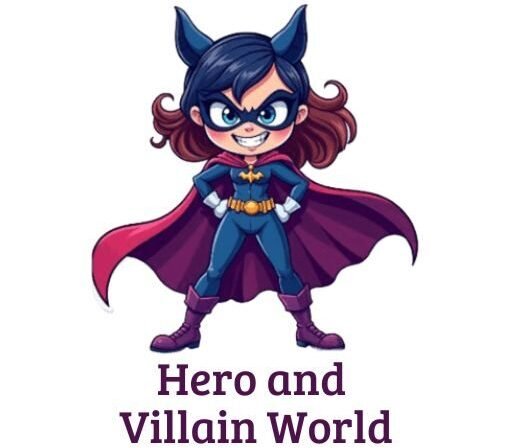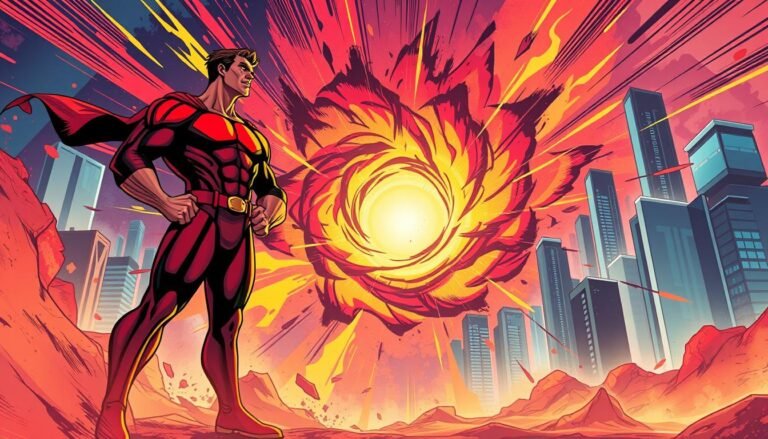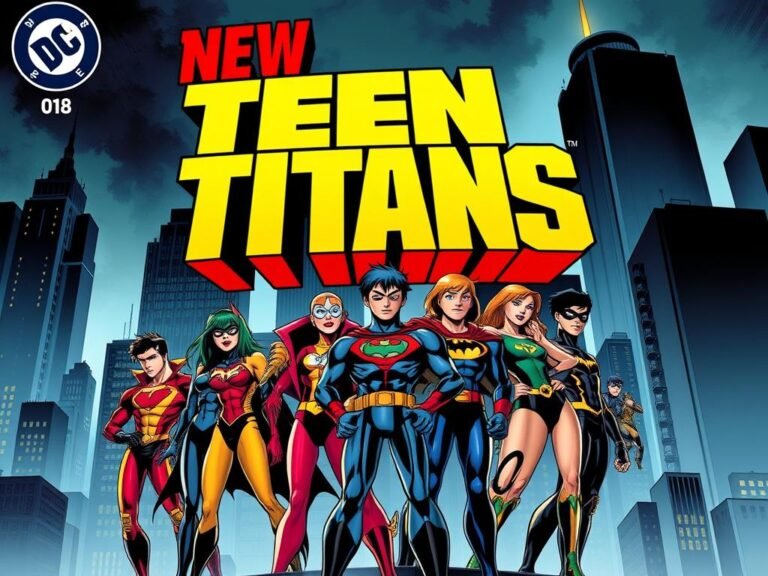The Flash: Terminal Velocity – Wally West’s Deep Dive and Mastery of the Speed Force
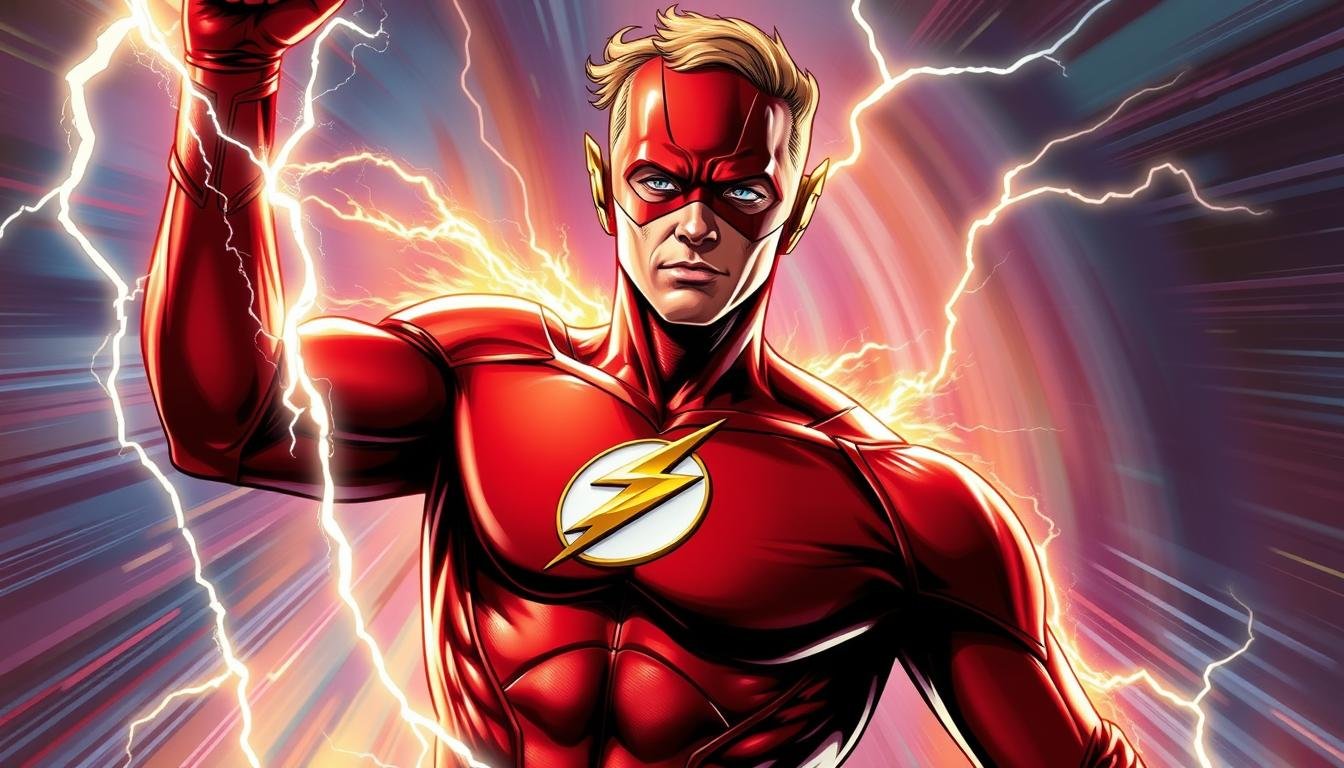
I’ll never forget the first time I picked up a comic featuring scarlet streaks racing across the pages. It wasn’t just the vibrant art or high-stakes battles that hooked me—it was the humanity beneath the mask. For years, I’ve been fascinated by how stories about superhuman abilities mirror our own struggles to grow, adapt, and find purpose.
Take terminal velocity, for example. In physics, it’s the point where gravity and air resistance balance—a concept that feels almost poetic when applied to characters like Wally West.
Once known as Kid Flash, he didn’t just inherit a title; he redefined what it meant to harness the Speed Force, that brilliant narrative device solving impossible feats like surviving friction at Mach 10.
Mark Waid’s iconic run didn’t just hand Wally a legacy. It made him earn it—through doubt, loss, and moments where raw velocity couldn’t outrun emotional stakes.
This journey from sidekick to hero mirrors our own battles to step into bigger roles, whether in careers, relationships, or personal growth.
What makes this series timeless isn’t just the science or spectacle. It’s how characters like Jay Garrick and Barry Allen paved the way for Wally’s evolution, showing that true power lies in embracing responsibility alongside ability.
And that’s what we’ll explore here: the physics, heart, and legacy woven into every lightning bolt.
Introduction to The Flash and the Legacy of Speed
My obsession with heroism began at a dusty flea market, where a tattered copy of The Flash #62 fell into my hands.
That comic didn’t just introduce me to Barry Allen—it revealed how superhuman abilities could mirror our deepest human truths. Over time, I realized why these stories stick: they’re not about moving fast, but about what we choose to chase.
My Journey Into the World of DC Comics
Growing up, I devoured every story about scarlet-clad heroes. Writers like Geoff Johns shaped my understanding of legacy, showing how each speedster built upon the last. Mark Waid’s introduction of the Speed Force was revolutionary—it gave scientific poetry to the impossible.
An Overview of Heroism and Super Speed
Superhuman pace isn’t just a power—it’s a narrative engine. Early comics struggled with questions: How do you run through walls? Survive cosmic collisions? The answer came through creative evolution:
| Speedster | Breakthrough | Impact |
|---|---|---|
| Jay Garrick | Golden Age Pioneer | Established moral code |
| Barry Allen | Silver Age Revival | Connected science to heroism |
| Wally West | Modern Complexity | Humanized cosmic power |
This progression mirrors how we grow—not by replacing predecessors, but by standing on their shoulders. Wally West’s journey from Kid Flash to legend proves that true heroism lies in balancing responsibility with raw potential.
The Evolution of Wally West: From Kid Flash to The Flash
There’s something profoundly relatable about a hero who starts as a sidekick. When Wally West first appeared in The Flash #110 (1959), he mirrored readers’ own dreams of stepping into bigger roles.
His early days as Kid Flash weren’t just about red costumes—they laid groundwork for one of comics’ most authentic growth arcs.
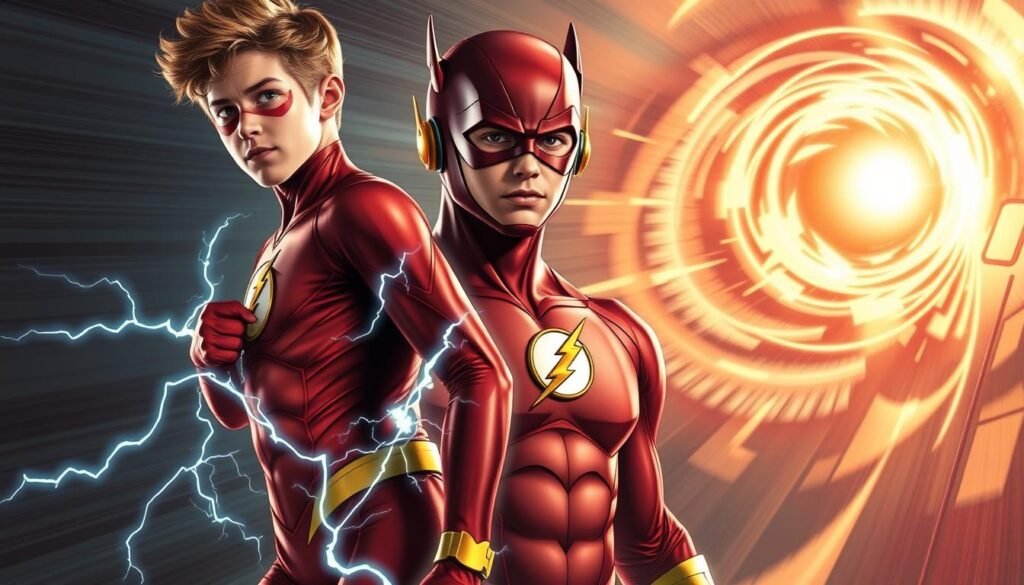
Growing Pains of a Scarlet Protégé
Wally’s journey wasn’t smooth. Early stories showed him grappling with self-doubt, especially after Barry Allen’s death in Crisis on Infinite Earths.
Fans watched him evolve from a quippy teen to someone wrestling with legacy. Writers gave him real stakes—like health issues from overusing his powers—that made his triumphs feel earned.
When the Lightning Chose Him
Taking the Speed Force-fueled mantle meant more than wearing a new suit. Post-Crisis comics forced Wally to redefine heroism without mimicking predecessors.
Mark Waid’s Flash run crystallized this shift, showing how Wally’s humor and vulnerability became strengths rather than weaknesses. Readers rallied behind this flawed, human version of the Flash—proof that legacies thrive when reshaped, not replicated.
I’ve always admired how DC let Wally stumble before soaring. His story reminds us that growth isn’t linear—it’s a series of choices, setbacks, and moments where we outrun our own doubts.
Understanding Terminal Velocity within the Flash Universe
Comic writers face a unique challenge: how to make physics serve drama. In The Flash, terminal velocity isn’t just a scientific concept—it’s a storytelling checkpoint. When Mark Waid redefined the Speed Force, he transformed it into a narrative Swiss Army knife.
Suddenly, impossible feats like surviving atmospheric friction or defying g-forces had plausible explanations rooted in comic-book logic.
Here’s the brilliant thing about terminal velocity in this context: it’s not a limit, but a threshold. Exceeding it triggers consequences that reshape entire arcs.
Wally West’s battles often hinged on this balance—pushing past conventional boundaries while facing repercussions like molecular instability or time displacement.
These stakes forced creative solutions, like using the Speed Force as an energy buffer during multiverse crossover events.
Why does this matter? Without these self-imposed rules, comics risk becoming predictable. By anchoring Wally’s growth to tangible limits, writers like Waid gave readers emotional anchors. Every time he outran death or rewritten history, we felt the weight of those victories.
This approach also solved pesky plot holes. How does a hero move faster than light without disintegrating? The answer lies in the Speed Force—a concept so flexible it lets characters evolve while honoring Barry Allen’s legacy.
Next, we’ll explore how these ideas set the stage for Wally’s most transformative moments.
Exploring flash terminal velocity speed force wally
I’ll never forget the panel where Wally West’s sneakers disintegrated mid-sprint—a visual metaphor for his connection to the Speed Force fraying under pressure.
The Terminal Velocity arc wasn’t just about breaking records—it tested whether he could reinvent heroism when physics itself seemed hostile.
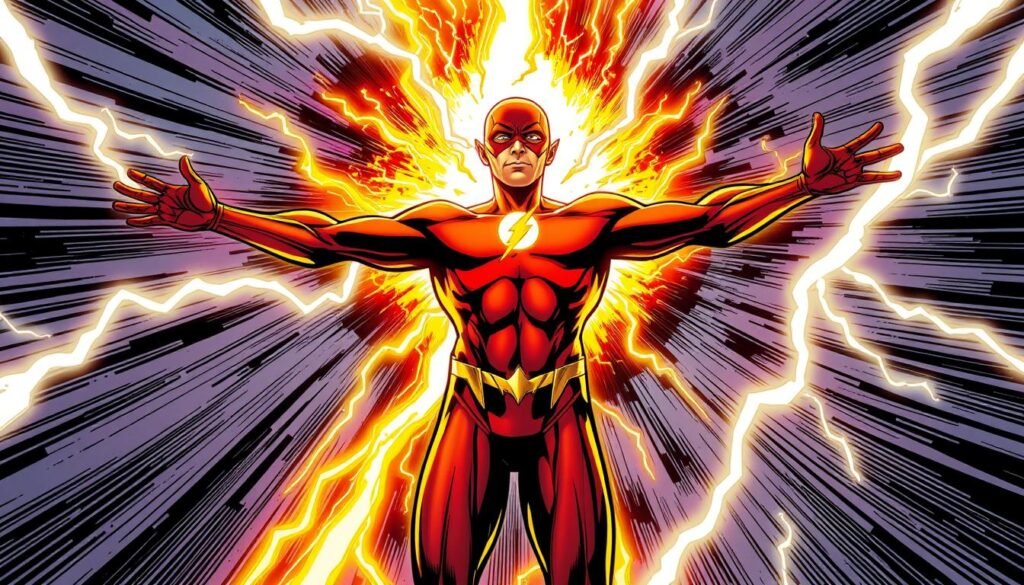
Writers used extreme scenarios to deepen his bond with the cosmic energy source. One issue showed him phasing through walls by syncing his molecules with the Speed Force’s rhythm—a skill Barry Allen never mastered.
These moments transformed Wally from a legacy hero into an innovator.
| Power Evolution | Before Terminal Velocity | After Terminal Velocity |
|---|---|---|
| Energy Control | Reactive | Intentional |
| Multiversal Travel | Accidental | Precision-Based |
| Speed Healing | Basic Recovery | Cellular Regeneration |
What fascinates me most is how these changes impacted his relationships. When he temporarily lost the Speed Force, stories focused on his ingenuity without powers—like using forensic skills learned from Barry. It proved his heroism wasn’t just about velocity, but adaptability.
The series didn’t just upgrade abilities—it redefined what a speedster could be. By tying Wally’s growth to tangible risks, writers made every victory feel earned.
That’s why decades later, these comics still resonate: they show that true legacy isn’t inherited—it’s built through grit and reinvention.
The Origins and Science Behind the Speed Force
What if I told you a comic book plot device could make physicists both cringe and nod in approval? That’s the Speed Force—a concept born from Mark Waid’s need to explain how heroes like Wally West defy physics daily.
Introduced in 1994, this cosmic energy source became DC’s Swiss Army knife for speedster logic.
Waid’s genius was retrofitting the Speed Force into earlier stories. Suddenly, Jay Garrick’s 1940s feats weren’t just “comic book magic”—they were taps into the same energy Barry Allen later harnessed.
Geoff Johns expanded this idea, turning it into a multiversal cosmic glue connecting every scarlet sprint.
The “science” here is delightfully fuzzy. Writers treat it like quantum physics meets mythology—vibrating molecules for phasing, time travel via cosmic treadmills. It’s not about accuracy, but story cohesion.
As Waid once said: “The Speed Force isn’t electricity or magic. It’s the thing that lets us care about someone running faster than light.”
Compare Jay’s Golden Age adventures to modern tales. His speed was just… there. Now, every velocity-based hero shares a connection to this narrative battery.
It’s why Wally West could evolve beyond Barry’s shadow—his struggles with the Force’s limits made him relatable despite godlike powers.
This concept didn’t just explain impossible feats. It let writers explore addiction, legacy, and responsibility through a sci-fi lens. The Speed Force became more than plot fuel—it’s the heartbeat of every great Flash story.
Diving into Terminal Velocity: Transformations and New Powers
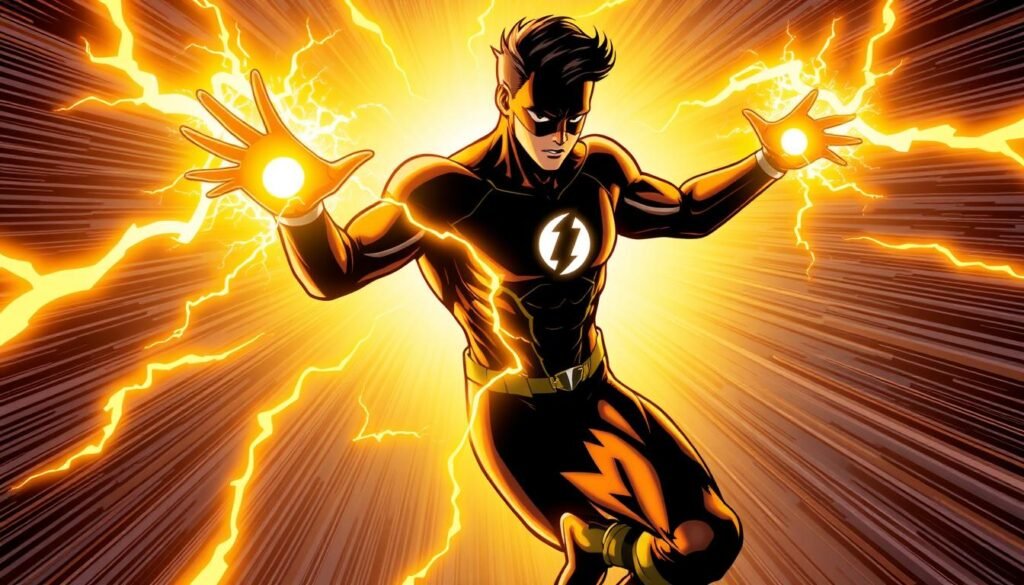
What happens when a hero’s greatest limitation becomes their key to evolution? The Terminal Velocity arc answered this by reshaping Wally West’s relationship with the Speed Force.
I remember gripping the comic as he shattered barriers, discovering abilities that redefined what a speedster could achieve.
One game-changer was his newfound capacity to share speed with allies. In issue #97, he temporarily granted Linda Park superhuman reflexes—a move that saved Central City from a collapsing bridge.
But this power came with risks. Writers cleverly balanced these moments with consequences, like Wally’s temporary energy depletion after each transfer.
| Power | Before Terminal Velocity | After Terminal Velocity |
|---|---|---|
| Speed Sharing | Non-existent | Tactical Team Boosts |
| Speed Stealing | Uncontrolled Absorption | Precision Drain |
| Multiversal Awareness | Limited Perception | Cross-Dimensional Sensing |
Mark Waid’s team didn’t just upgrade Wally—they made his growth matter. When he began stealing kinetic energy from foes, it created moral dilemmas.
Could he justify draining a villain’s life force to save others? These twists kept the series unpredictable while deepening character development.
“Terminal velocity wasn’t a barrier—it was a doorway,”
Seeing Wally master these skills felt personal. His journey mirrored moments when we discover hidden strengths during crises.
The creative team’s bold choices didn’t just elevate his story—they expanded DC’s cosmic lore, influencing later arcs like Chain Lightning and Flashpoint.
This evolution proved that even legacy heroes could innovate. By embracing change—both in powers and purpose—Wally West became more than Barry Allen’s successor. He became proof that true heroism adapts while staying grounded in humanity.
Narrative Shifts: Terminal Velocity vs. The Return of Barry Allen Saga
When two iconic storylines collide, the narrative tremors reshape entire universes. Terminal Velocity and The Return of Barry Allen each redefined what superhuman pace could mean—but through radically different lenses. One pushed boundaries, while the other resurrected ghosts.
Mark Waid’s Terminal Velocity centered on Wally West’s metamorphosis. Here, the Speed Force became a tool for growth rather than a crutch.
Scenes like his molecular fusion with cosmic energy showcased innovation—a hero evolving beyond his mentor’s shadow.
In contrast, Barry Allen’s return during the 1990s saga forced Wally to confront legacy. Writers used timeline disruptions from Crisis on Infinite Earths to explore identity crises.
When a twisted version of Barry (later revealed as the Dark Flash) emerged, it symbolized Wally’s fear of being replaced.
| Element | Terminal Velocity | Return of Barry Allen |
|---|---|---|
| Speed Force Role | Evolutionary Catalyst | Legacy Anchor |
| Central Conflict | Mastering New Powers | Preserving Heroic Identity |
| Timeline Impact | Future-Altering Choices | Past Haunting Present |
These arcs also reimagined lost speed concepts. Terminal Velocity treated velocity as a renewable resource, while Barry’s resurrection storyline framed it as fragile—something that could vanish if history unraveled.
This duality later influenced events like Doomsday Clock, where timeline stability became paramount.
What fascinates me is how both tales used the same cosmic rules to tell opposing stories. One looked forward, the other backward—yet together, they deepened DC’s exploration of legacy and progress. That tension? It’s why these flash stories still spark debates at comic cons today.
The Role of Supporting Characters in Wally West’s Journey
Heroes rarely soar alone—their greatest growth happens when others push them beyond self-doubt. For me, characters like Jesse Quick and Impulse weren’t just allies to Wally West; they became mirrors reflecting his untapped potential.
Their interactions in teams like the Teen Titans and Justice League transformed solo sprints into collaborative triumphs.
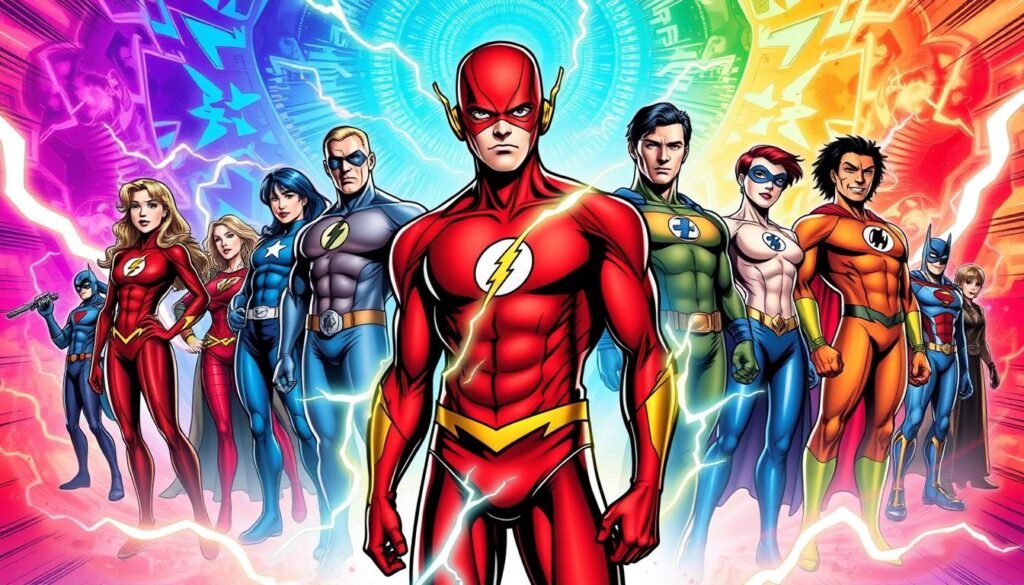
Take Jesse Quick’s no-nonsense approach. As a legacy hero herself, she challenged Wally to honor Barry Allen’s teachings while forging his own path. Their banter during missions often hid deeper respect—a dynamic that kept the series grounded.
When Jesse temporarily led the Titans, Wally’s playful rivalry masked genuine admiration for her leadership.
Then there’s Impulse, the hyperactive speedster who arrived like a tornado. His reckless energy forced Wally into mentorship—a role he initially resisted. Writers cleverly used their bond to explore generational growth.
One arc showed Wally teaching Impulse to channel his speed thoughtfully, echoing lessons from Barry’s early days.
| Team | Dynamic | Impact on Wally |
|---|---|---|
| Teen Titans | Peer Collaboration | Sharpened Strategic Thinking |
| Justice League | Leadership Challenges | Deepened Sense of Responsibility |
These relationships added layers to the story. When Wally faced cosmic threats, teammates like Linda Park reminded him why humanity matters. Their shared struggles—like rebuilding after invasions—made victories feel collective rather than individual.
What makes these bonds timeless? They prove heroism thrives through connection. Just as Barry’s legacy shaped Wally, his allies pushed him to evolve beyond limits.
Every partnership in the series whispers the same truth: greatness isn’t born in isolation—it’s forged through trust and friction.
Examining the Cultural Impact of Flash Stories
Stories about scarlet streaks don’t just entertain—they ripple through culture like shockwaves. When Mark Waid reimagined the Speed Force in the 90s, he unknowingly shaped how modern superhero tales balance science and heart.
From CW’s The Flash series to Zack Snyder’s Justice League, you can spot DNA from comics like Doomsday Clock in every timeline twist.
Think about how Barry Allen’s sacrifice in Crisis on Infinite Earths became a blueprint for heroic selflessness. Or how the Dark Flash storyline’s moral ambiguity inspired shows like WandaVision.
These narratives didn’t just sell comics—they taught audiences that heroism thrives in shades of gray.
Even the Doomsday Clock metaphor—a ticking countdown to chaos—found new life beyond panels. It’s echoed in climate change documentaries and political thrillers, proving comic themes can transcend genres.
As one writer noted: “Superhero stories are modern myths—they adapt to reflect our fears and hopes.”
With upcoming Flash films exploring multiverse madness, fans debate how faithfully adaptations should honor source material. But that tension? It’s proof these stories still matter. They remind us that legacy isn’t about preserving the past—it’s about sprinting toward better futures.
Wally West and the Broader DC Speedster Mythology
Every time I trace the lightning bolt emblem across a Flash comic, I’m reminded of how Wally’s journey stitches together generations of DC’s fastest heroes.
His story isn’t just about outrunning villains—it’s about weaving a legacy that honors predecessors while carving new paths. When Mark Waid took over the series, he didn’t just give Wally powers—he gave him purpose.
Compare his growth to legends like Jay Garrick and Barry Allen. Jay embodied wartime resilience, while Barry fused science with heroism.
Wally? He became the bridge between eras. Geoff Johns later deepened this by exploring his connection to the Speed Force as both gift and burden—a theme that resonates in arcs like Infinite Earths.
| Speedster | Legacy Theme | Creator Influence |
|---|---|---|
| Jay Garrick | Golden Age Perseverance | Foundational Values |
| Barry Allen | Silver Age Innovation | Scientific Curiosity |
| Wally West | Modern Relatability | Waid/Johns Emotional Depth |
Leadership emerges in unexpected ways. During the Dark Flash saga, Wally faced a twisted version of Barry—forcing him to confront fears of inadequacy. These trials mirrored real-world struggles to step into roles we feel unready for.
Yet through cosmic crises and personal doubts, he proved that true leadership isn’t about speed—it’s about inspiring others to keep running.
What makes his arc timeless? It’s much like our own journeys—balancing respect for the past with courage to redefine the future.
Whether teaming with Titans or guiding new heroes, Wally West’s story reminds us that legacies aren’t static. They’re living tapestries, forever being rewoven.
The Intersection of Science and Fiction in Speed Force Lore
Exploring the Speed Force feels like solving an equation where variables are replaced with pure imagination.
Mark Waid’s run treated it as both cosmic battery and character—a paradox that lets writers bend physics without breaking story logic. How else could a hero outrace time itself yet struggle with relatable doubts?
Take the Doomsday Clock concept—a literal countdown to universal collapse. By linking it to the Speed Force’s instability, DC transformed abstract science into gripping stakes.
When Crisis on Infinite Earths reshaped timelines, writers used this energy source to explain paradoxes, making multiverse chaos feel strangely plausible.
What fascinates me most is how creators balance technical jargon with emotional resonance. Waid once described the Speed Force as “the answer to questions we’re too entertained to ask.”
This approach lets fans enjoy Barry Allen’s light-speed battles while ignoring relativistic consequences—like why Central City isn’t constantly engulfed in fusion-level explosions.
“The Speed Force isn’t science—it’s the poetry of motion.”
Even upcoming Flash adaptations borrow this duality. The Speed Force appears as swirling energy in films, yet its rules remain delightfully vague.
That mystery? It’s why this concept endures. By blending quantum buzzwords with mythic symbolism, DC keeps us hooked—proving that sometimes, the best science is the kind we don’t overthink.
The Art and Writing Behind Terminal Velocity
Creating comic magic requires more than just ink and paper—it demands a symphony of minds. When Mark Waid and Geoff Johns teamed up for Terminal Velocity, they didn’t just write a story.
They engineered a blueprint for balancing cosmic scope with intimate character growth. Their collaboration redefined how superhero tales could blend scientific wonder with emotional stakes.
Artists faced a unique challenge: making the Speed Force visually tangible. Early issues used jagged lightning bolts and motion blurs, but Terminal Velocity introduced swirling energy fields that mirrored Wally’s evolving connection.
Colorists shifted palettes during key scenes—cool blues for stability, fiery reds for chaos—to mirror internal struggles.
| Creative Element | Pre-Terminal Velocity | Post-Terminal Velocity |
|---|---|---|
| Visual Design | Static Lightning Trails | Dynamic Energy Waves |
| Narrative Approach | Linear Hero Journeys | Multilayered Timelines |
| Fan Reception | Niche Appeal | Cross-Generational Impact |
Crossovers like Crisis on Infinite Earths added depth by weaving history into Wally’s arc. Writers used these events as pivot points, showing how legacy heroes adapt when universes collide.
The Doomsday Clock motif later amplified tension, symbolizing irreversible consequences if the Speed Force destabilized.
What stays with me is how these creators balanced spectacle with heart. As one critic noted: “They turned physics into poetry.” Their work didn’t just shape upcoming Flash projects—it proved that collaboration fuels innovation, much like the energy source they brought to life.
Power, Leadership, and Personal Growth in Flash Narratives
Leading isn’t about being fastest—it’s about knowing when to slow down. Wally West’s greatest trials often came not from villains, but from moments demanding wisdom over raw super speed.
During Crisis on Infinite Earths, his choice to prioritize civilian evacuation over chasing Reverse-Flash redefined heroism as service, not spectacle.
One flash annual issue captured this perfectly. Faced with a destabilized Speed Force, Wally had seconds to decide: save his team or reset the cosmic balance.
His gamble—using his connection speed to absorb excess energy—nearly erased him from existence. Yet it showcased how true leadership means embracing sacrifice.
| Challenge | Action | Growth |
|---|---|---|
| Dark Flash Saga | Confronting legacy fears | Rejecting toxic comparisons |
| Lost Speed Force Arc | Mastering energy conservation | Trusting allies’ strengths |
Crossover events amplified these themes. When multiverse threats emerged, Wally’s ability to coordinate heroes—not outpace them—became his defining trait. It’s a lesson I’ve carried into my own life: real power lies in elevating others, not just yourself.
What sticks with me is how flash comics frame growth. Every surge forward risks losing what makes us human. But as Wally proved, the point isn’t avoiding stumbles—it’s learning who you become when you rise.
Conclusion
Closing this chapter on scarlet streaks and cosmic energy, I’m struck by how deeply these stories mirror our own quests for growth.
Wally West’s journey—from uncertain protégé to Zen Master of Speed—reminds us that true mastery isn’t about raw power. It’s about evolving through struggle, just as he did during narrative breakthroughs that reshaped DC’s mythology.
The Speed Force remains one of comics’ most brilliant metaphors. It turns scientific impossibilities into emotional truths, letting heroes like Wally face cosmic stakes while staying relatable.
Whether confronting the Dark Flash or repairing fractured timelines, his victories always felt human-sized.
These tales endure because they balance wonder with wisdom. They ask: What do we sacrifice for progress? How do we honor the past without being chained to it? Watching Wally navigate these questions taught me that legacy isn’t inherited—it’s built through choices.
As new adaptations emerge, I hope they capture this heart. After all, the best super speed stories aren’t about moving fast. They’re about learning when to pause, reflect, and let others shine—lessons that never lose their urgency.
FAQ
Q: How did Wally West transition from Kid Flash to becoming The Flash?
A: I watched Wally grow from a young, eager sidekick into a hero who carried Barry Allen’s legacy. After Barry’s sacrifice in Crisis on Infinite Earths, Wally stepped up, struggled with self-doubt, and eventually embraced his role. His journey wasn’t just about super-speed—it was about proving he could honor the mantle while forging his own path.
Q: What makes Terminal Velocity a pivotal story for Wally West?
A: This arc showed Wally mastering abilities beyond raw speed, like phasing and time travel. It wasn’t just power-ups—it deepened his bond with the Speed Force and solidified his confidence as a leader. For me, it’s where he stopped being “Barry’s replacement” and became his own Flash.
Q: How does the Speed Force blend science and fiction in DC’s universe?
A: Writers like Mark Waid treated it as both a cosmic energy source and a metaphor for legacy. It’s rooted in pseudoscience—think quantum physics and relativity—but also has mystical elements. This mix lets storytellers explore themes like responsibility and connection without losing that comic-book wonder.
Q: Who were key figures in Wally’s growth during Terminal Velocity?
A: Linda Park, his eventual wife, kept him grounded. Veterans like Jay Garrick offered wisdom, while foes like Kobra challenged his limits. These relationships weren’t just subplots—they shaped his humanity and showed why he’s more than just a speedster.
Q: Why do stories like Terminal Velocity resonate culturally?
A: They’re about overcoming imposter syndrome and embracing change—themes everyone relates to. Wally’s struggles with identity and purpose mirror real-life growth, making his victories feel earned. Plus, the blend of high-stakes action and heartfelt moments keeps readers hooked across generations.
Q: How does Terminal Velocity differ from The Return of Barry Allen saga?
A: While both focus on legacy, Terminal Velocity is about Wally owning his role, whereas Return deals with confronting the past. The former is hopeful and forward-looking; the latter is darker, questioning what it means when icons come back. Both highlight Wally’s complexity as a character.
Q: What role did Mark Waid play in redefining Wally West?
A: Waid’s writing gave Wally emotional depth and humor, making him relatable. He shifted focus from tragedy to legacy, showing how heroism isn’t just about power—it’s about heart. For me, Waid’s run turned Wally from a backup hero into a legend in his own right.
